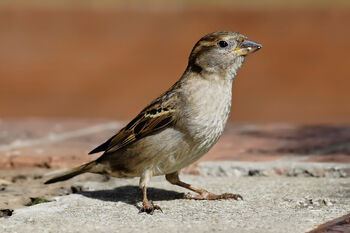No edit summary Tag: Visual edit |
(spelled steal wrong) Tag: Visual edit |
||
| (4 intermediate revisions by 4 users not shown) | |||
| Line 1: | Line 1: | ||
| + | |||
| − | {{Backto}} |
||
{{More}} |
{{More}} |
||
| ⚫ | |||
| ⚫ | '''Ornithophobia''' (from Greek ''ornitho'', "bird") is the fear of {{wp|bird}}s. Sufferers would be uncomfortable being outdoors and seeing or hearing |
||
| ⚫ | |||
| ⚫ | |||
| + | |||
| ⚫ | '''Ornithophobia''' (from Greek ''ornitho'', "bird") is the fear of {{wp|bird}}s. Sufferers would be uncomfortable being outdoors and seeing or hearing birds may make them dread, anxious, or panic depending on severity of one's phobia. Some ornithophobes may only fear certain harmful birds, like vultures, hawks, eagles, falcons, owls, ospreys, chickens, and geese, while others may even fear household and normally found harmless birds like crows, sparrows, parrots, and parakeets. |
||
| + | |||
| ⚫ | There are causes of ornithophobia, such as letting birds in the house through opened windows. Other causes include folklore and movies that portray birds, like {{wp|Alfred Hitchcock}}'s film {{wp|''The Birds''}} and Edgar Allen Poe's poem {{wp|''The Raven''}}, and even birds attacking rabbits on TV. |
||
| − | Some people refuse to eat in places where birds may be present because of the fear that birds can |
+ | Some people refuse to eat in places where birds may be present because of the fear that birds, such as seagulls and pigeons, can steal their food. Ornithophobes are afraid of birds preserved by in museums and other places. Still others are afraid of images, photos, feather, or even hearing the word "bird". Physical symptoms of this phobia typically include breaking in cold sweat, trembling or shaking, screaming, or crying, having an increased heart rate, freezing in place, or attempting to flee at the sight of birds. Sufferers would stay inside the house at all times during the day with all the windows and shades closed. Ornithophobes may prefer to be nocturnal, meaning that they sleep during the day and be active at night (which most people do not do). |
For people with severe symptoms of ornithophobia, tranquilizers or other medicine can be used to reduce the severity of the symptoms. Ornithophobia can be treated using {{wp|behavioral therapy}}, which is effective 90% of the times, and {{wp|Gradual desensitization}}, which is another effective method. Ten to thirty sessions (depending on individual cases) may be used for exposing the person to his/her objects of fears. The patient is shown slides or images of birds or their feathers, taught to imagine approaching the birds until s/he gradually learns to cope without distress. |
For people with severe symptoms of ornithophobia, tranquilizers or other medicine can be used to reduce the severity of the symptoms. Ornithophobia can be treated using {{wp|behavioral therapy}}, which is effective 90% of the times, and {{wp|Gradual desensitization}}, which is another effective method. Ten to thirty sessions (depending on individual cases) may be used for exposing the person to his/her objects of fears. The patient is shown slides or images of birds or their feathers, taught to imagine approaching the birds until s/he gradually learns to cope without distress. |
||
Revision as of 02:20, 20 May 2021
Wikipedia has more on Ornithophobia.

A sparrow.
Ornithophobia (from Greek ornitho, "bird") is the fear of birds. Sufferers would be uncomfortable being outdoors and seeing or hearing birds may make them dread, anxious, or panic depending on severity of one's phobia. Some ornithophobes may only fear certain harmful birds, like vultures, hawks, eagles, falcons, owls, ospreys, chickens, and geese, while others may even fear household and normally found harmless birds like crows, sparrows, parrots, and parakeets.
There are causes of ornithophobia, such as letting birds in the house through opened windows. Other causes include folklore and movies that portray birds, like Alfred Hitchcock's film The Birds and Edgar Allen Poe's poem The Raven, and even birds attacking rabbits on TV.
Some people refuse to eat in places where birds may be present because of the fear that birds, such as seagulls and pigeons, can steal their food. Ornithophobes are afraid of birds preserved by in museums and other places. Still others are afraid of images, photos, feather, or even hearing the word "bird". Physical symptoms of this phobia typically include breaking in cold sweat, trembling or shaking, screaming, or crying, having an increased heart rate, freezing in place, or attempting to flee at the sight of birds. Sufferers would stay inside the house at all times during the day with all the windows and shades closed. Ornithophobes may prefer to be nocturnal, meaning that they sleep during the day and be active at night (which most people do not do).
For people with severe symptoms of ornithophobia, tranquilizers or other medicine can be used to reduce the severity of the symptoms. Ornithophobia can be treated using behavioral therapy, which is effective 90% of the times, and Gradual desensitization, which is another effective method. Ten to thirty sessions (depending on individual cases) may be used for exposing the person to his/her objects of fears. The patient is shown slides or images of birds or their feathers, taught to imagine approaching the birds until s/he gradually learns to cope without distress.
Swedish film director Ingmar Bergman, American actress Scarlett Johansson, Irish singer Niall Horan, and American actress Lucille Ball are notable sufferers of ornithophobia. On the day Lucille Ball's father died, a bird had become trapped in the house, and since that time she suffered from the phobia until she died.